As the National Nutrition Month draws to a close, Salome Yesudas illustrates the need for considering the local food systems for achieving food and nutrition security, especially among the most vulnerable communities. Extension and Advisory Services could play a very important role in promoting local food systems, she argues.
BACKGROUND
“India is my country and all Indians are my brothers and sisters. I love my country and I am proud of its rich and varied heritage. I shall always strive to be worthy of it.” During my school days – that means for 10 years every day – we used to repeat the pledge in English and Telugu.
‘Rich and varied heritage’ talks about the diversity of India, its people, cultures, languages, and of course, food. Today sadly the picture of diversity is fading. As a community nutritionist and a researcher, I observe that food diversity is reducing day by day and monotonous insipid substitutes are cropping up for nutrition and food security. Given the rich and varied diversity in agriculture, uncultivated foods and forest foods, India should never suffer from dietary monotony or be one of the last in the nutrition and health index (Box 1).
| Box 1: India’s Nutrition Situation India has been engaged in an age-old battle to combat the issue of malnutrition. Even seven decades after Independence, despite having several policies and programmes aimed at reducing malnutrition, India’s performance in this area has been consistently poor. The UNICEF report, The State of World’s Children, 2019, noted that 69% of the deaths of children below the age of five in India is due to malnutrition, and every second child in that age group is affected by some form of malnutrition (stunting, wasting, overweight). The report finds that 35% of the children suffered from stunting, 17% from wasting, and 33% from underweight. Devastatingly, wasting among children under five years of age rose to 20.8% in 2019 from 16.5% in 2010, according to the Global Hunger Index (GHI) released in October 2019. The report also noted that ‘India ranked 102 on the index among 117 qualifying countries with a score of 30.3’. Only 42% of children between the ages of six and 23 months were fed at an adequate frequency, while only 21% received an adequately diverse diet. Moreover, every second, a woman was found to be anaemic, while 40.5% of children were also found to be suffering from the same condition (EPW, 2019). Recognising that multifactorial interventions are required to address malnutrition in the country, the Poshan Abhiyan or National Nutrition Mission launched in 2017-18, work towards ‘mapping of various schemes contributing towards addressing malnutrition’ and ‘introducing a very robust convergence mechanism’. However, in the first three years of its implementation, the focus seems to have been largely on setting up the ICDS_CAS (common application software) mechanisms for real-time monitoring of anganwadi services and on conducting public awareness campaigns on malnutrition, While this has helped bring the issues to the forefront, a comprehensive response to malnutrition call for much more (Sinha, 2020). |
Note: Stunting refers to moderate and severe – below minus two standard deviations from median height for age of reference population, whereas wasting refers to moderate and severe – below minus two standard deviations from median weight for height of reference population.
The GHI calculated hunger level and under nutrition worldwide by considering four indicators – undernourishment, child wasting, child mortality and child stunting.
LOCAL FOOD SYSTEMS
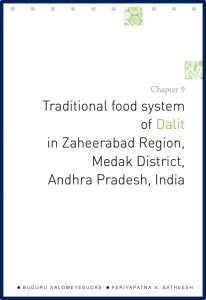 Especially during the COVID-19 situation local foods are the best option where there is limited mobility and suspicion about infection sources, and uncertainty with regard to safety measures in the absence of clear evidence-based guidelines. Every step outside the home is scary but necessary as the poorest of poor families are most affected by COVID-19 restrictions.
Especially during the COVID-19 situation local foods are the best option where there is limited mobility and suspicion about infection sources, and uncertainty with regard to safety measures in the absence of clear evidence-based guidelines. Every step outside the home is scary but necessary as the poorest of poor families are most affected by COVID-19 restrictions.
According to Bioversity international, ‘When looking at diet quality and diversity, it is important to consider food systems as a whole. This means considering all the complex dimensions of a food system not just what is in a diet: production to processing; the marketability of local foods; natural resource management; and resilience to external stresses such as climate change. Taking this perspective means you are better able to understand how interventions can contribute to food systems in a sustainable and healthy way.’
Local foods include not only that from farms but also from fences, hedges, neighbourhoods, forests, ponds, rivers, streams and also the plants that grow along with main crops and weeded systematically two to three times per season in all crops. These plants which are termed as weeds are often collected by women for food, fodder and medicinal purposes. Some of these plants are incredibly rich in micronutrients. These plants are available round the year – both in rainfed and irrigated fields.
When we are looking for opportunities to enhance nutrition security, ‘Forest foods and Uncultivated foods’ should take priority in recommendations, but today sadly hybrid seeds, vegetable packets, packed foods, and ready to eat foods are most recommended which easily allow the junk food industry to thrive. Dr Shatrugna from the ICMR-National Institute of Nutrition (NIN), noted with concern that “beneficiaries of the anganwadi are led to believe that only what is packaged is good for children and anything prepared at home or which is traditional is not healthy and nutritious. It will delegitimize our rich food diversity, preparing our children for hamburgers, pizzas and colas” (Misra 2015).
In public food programmes it is important to provide children with natural and culturally-native foods, which can also be prepared with the same levels of nutrition and hygiene as packaged mixes. Deliberately during formative years children should be introduced to the local food basket rather than the junk food dustbin.
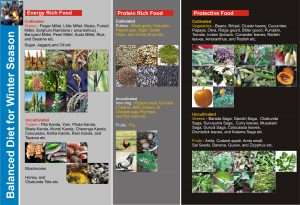 Source: https://livingfarms.co.in/
Source: https://livingfarms.co.in/
In rural areas, before spraying pesticides weeding is done across the rainfed and irrigated fields irrespective of the crops grown. While weeding, women with precision collect weeds for food, fodder and medicinal uses. From late June till next March one plant or the other from cultivated fields will be available for cooking. These greens are delicious, some are seen as auspicious, and almost all are packed with micronutrients. (For more details, kindly see Yesudas et al. 2009.)
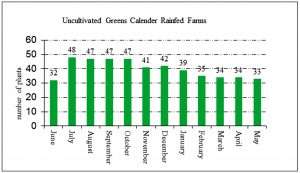 Source: Yesudas et al. (2009.)
Source: Yesudas et al. (2009.)
Same is the case with Forest foods as found from a study carried out in Odisha in two districts. Even today, in spite of so much destruction of forests, still the tribal food basket contains 12% to 24.8% forest foods around the year. The richness in forest food diversity is mind-boggling – just based on the data from 6 villages we found 21 varieties of wild edible fruits, 33 greens, 13 roots and tubers, 20 mushrooms, and about 11 other foods such as Red Ant Egg, etc. This study, ‘Living Farms’, Odisha, points out how uncultivated foods are not only safe, but also diverse and nutritious. Focussed on select villages of Rayagada and Sundargarh districts, the study also dwelt on socio-economic changes that are making it difficult to access the forest produce due to shrinking tree cover.
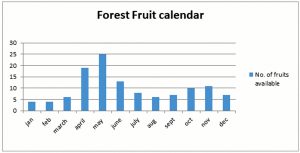 Source: Deb et al. (2014.)
Source: Deb et al. (2014.)
Apart from all these merits their nutrient content is mind blowing – rich in iron, calcium, zinc, magnesium, vitamin C, and beta carotene – and it is also very safe, free from human adulteration and chemical contamination. These foods can be easily accepted and accessed in villages. Therefore it’s high time we include them in all government/public food systems, especially where vulnerable groups are the beneficiaries.
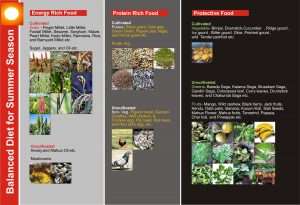 Source: https://livingfarms.co.in/
Source: https://livingfarms.co.in/
The use of forest foods is very common and makes a substantial contribution to the food and nutritional security of tribal people. It is important to undertake extensive education about their importance as a nutritionally balanced food and as a direct and indirect source of income. Many of the forest foods may not be available in future due to habitat destruction and various other calculated developmental reasons. So efforts must be taken to protect the ecosystem rather than just protecting one or two species as super foods. It is important, and the responsibility of older generations to transfer knowledge to younger generations for continuous conservation and consumption. These foods are a community’s wealth (treasure) which are also threatened very much due to human greed and intervention. To be worthy of this food wealth we should honestly strive to protect it so as to enhance not only our health and nutritional status but also the health of the entire ecosystem for the wellbeing of all humanity.
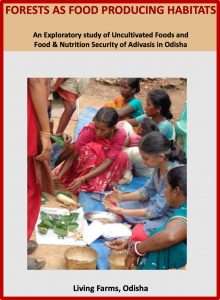 Another equally important portion of the pledge is “I shall always strive to be worthy of it”. If all of us, as responsible Indians really believe in this pledge, our food and nutrition security would have put India in the first five places of the index.
Another equally important portion of the pledge is “I shall always strive to be worthy of it”. If all of us, as responsible Indians really believe in this pledge, our food and nutrition security would have put India in the first five places of the index.
Let us see how we can strive to be worthy of it.
- Recognize and protect all sources of food;
- Minimize forest diversions (total withdrawal from commercial utilisation may be the best option);
- Food composition analysis of all uncultivated foods and forest foods that are consumed frequently should be done;
- Other than food and nutrition, other values associated with Uncultivated foods & Forest foods should be documented for local use;
- Researchers and research institutions should be made accountable to local knowledge providers and all rights should be with villagers;
- General trend is 3-Cs: Consumption, Conservation and Commercialising, but end up with exhaustive commercialisation leading to destruction of the source itself;
- Prepare dietary diversity registers, including cultivated foods for each Panchayath, that become their official document for future reference;
- Ensure the maintenance of uncultivated food sources in and around the immediate environment as common resources accessible to the community.
IMPLICATIONS FOR EXTENSION AND ADVISORY SERVICES
To bring back these foods into the mainstream nutrition programmes, Agriculture Extension and Advisory Services (EAS) have a key role to play.
At the district level, the KVKs, ATMA and district level extension centres (e.g., DAATT centres in Telanagana and Andhra Pradesh) should conduct a survey on uncultivated foods and forest foods available locally, and promote these foods by organizing extension programmes. They have an advantage due to their familiarity with local surroundings, including people.
Agriculture and allied courses should include ‘Uncultivated foods & forest foods’ in their curriculum.
Capacity building programmes on uncultivated foods and forest foods should be a priority for Extension Education Institutes (EEIs), SAMETIs, and University Departments dealing with Nutrition.
All the extension institutes should include the realisation of nutritional security in their mandate so as to help achieve nutrition secure and healthy communities.
Several NGOs, such as Dhan Foundation, Deccan Development Society, Living Farms, Social Action for Community Alternative Learning (SACAL) have developed information, education and communication materials on these aspects, and their expertise should be used for strengthening training in this area.
END NOTE
Addressing nutritional security, especially of those groups that are highly vulnerable to malnutrition, is an important priority for India. Uncultivated foods and forest foods can definitely play a key role – if they are included in mainstream nutrition programmes, especially those focussing on nutrition sensitive agriculture. Concerted efforts to develop capacities of extension staff in the agriculture, nutrition and health sectors, on the importance and use of uncultivated foods and forest foods are critical if we are to be serious about addressing malnutrition.
References
Deb Debal, Kuruganti Kavitha, Rao V Rukmini and Yesudas Salome. 2014. Living farms, Bhubaneswar. https://livingfarms.co.in/wp-content/uploads/2019/12/6-Forests-as-Food-producing-habitat.pdf
Economic and Political Weekly, The scourge of hunger and malnutrition. Editorials · Vol. 54, Issue No. 44, 09 November 2019.
Misra SS. 2015. ICDS gets packaged food for the malnourished. Down to Earth (July 2015). https://www.downtoearth.org.in/news/icds-gets-packaged-food-for-the-malnourished-4301
Sinha, D 2020. The Problem, Justice on our plates- a symposium on how to solve the problem of malnutrition, Seminar 730- June 2020.
Yesudas BS, Periyapatna V and Satheesh V. 2009. Traditional food system of Dalit in Zaheerabad Region, Medak District, Andhra Pradesh, India. Chapter 9 in: Indigenous peoples’ food systems: The many dimensions of culture, diversity and environment for nutrition and health (Kuhnlein Harriet V, Erasmus Bill and Spigelski Dina, eds.). Rome: Food and Agricultural Organisation.
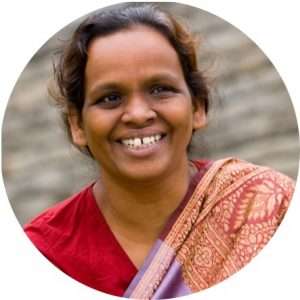 Ms Salome Yesudas is an independent researcher who has worked very closely with different communities in many states of India. She has also worked with the Global Health Project led by McGill University, Canada, in 12 countries on all the continents on local food systems. She continues to work with marginalised communities from different regions on local food systems for food and nutrition security. (salomeyesudas@hotmail.com)
Ms Salome Yesudas is an independent researcher who has worked very closely with different communities in many states of India. She has also worked with the Global Health Project led by McGill University, Canada, in 12 countries on all the continents on local food systems. She continues to work with marginalised communities from different regions on local food systems for food and nutrition security. (salomeyesudas@hotmail.com)

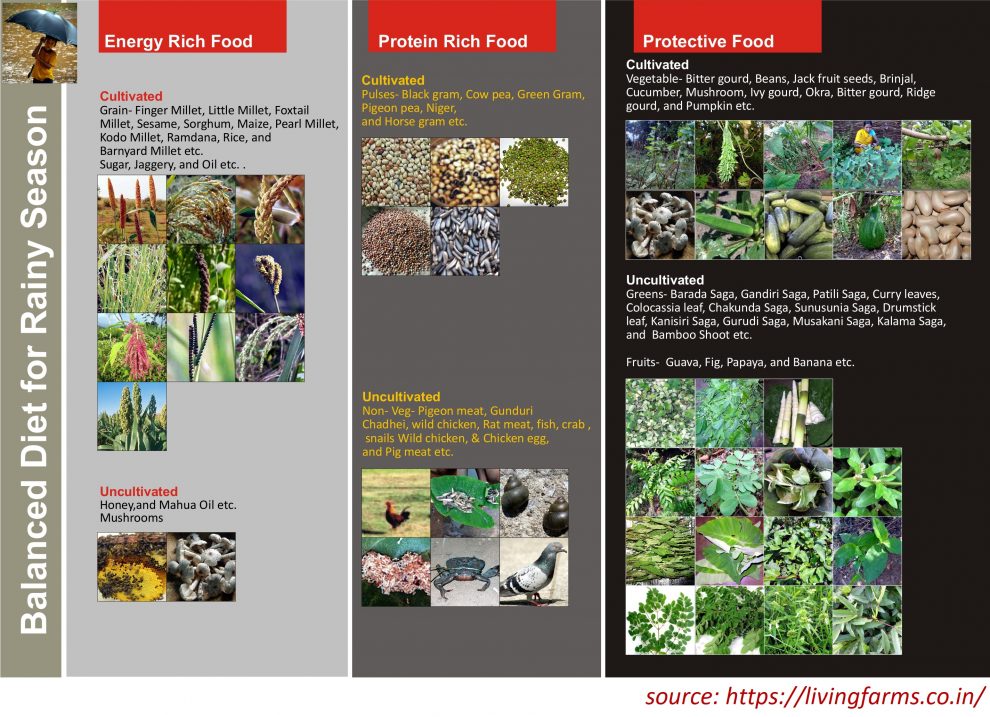

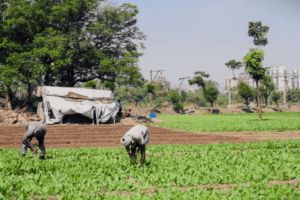

Educates about an important missing component of our fight against hunger and malnutrition. We are searching solutions elsewhere whereas it is abundant round the year within our own garden, fences, hedges, ponds, rivers, neighborhoods, as weeds along with cultivated plants, and nearby forest. The tragedy is that most do not know their worth! Somewhat realized during Covid19 pandemic! Well said that we should gear up to recognize them and build into our development programs on food and nutrition and in that the role of extension and advisory services is invaluable. Great message, Congratulations!
An excellent description of the importance of local food systems in maintaining the dietary diversity and nutritional security. Anecdotal evidence suggests that most of the government organizations are mainly concerned about research and development of major crops. While NGOs and community level organisations are working to create awareness and promote the local food crops. MSSRF is such an organization working extensively in this area. Knowledge on these crops would be vital in filling the gap in the pursuit of developing nutritional secure dietary recommendation.
“Thanks to the author for enriching my knowledge on uncultivated foods and forest foods and their importance in mitigating malnutrition especially of the vulnerable sections of the society. The message is clear “ avoid packed foods and include local foods .” But unfortunately our mind set is such that we give preference to junk food to local food ( ghar ki murgi daal barabar) which as the author rightly pointed out helps the Food processing industry to flourish at the cost of the consumers’ health. Congratulations to Ms Salome Yesudas for giving us very useful information through this blog and also for the ways and means to bring back these forgotten foods to the main stream”.